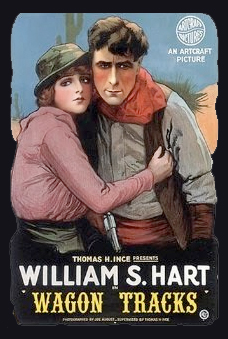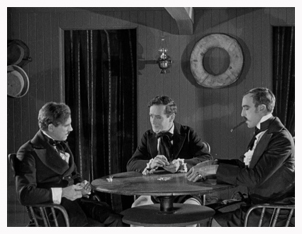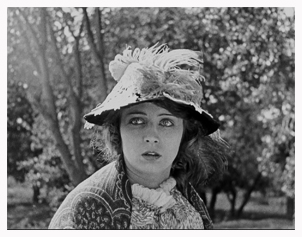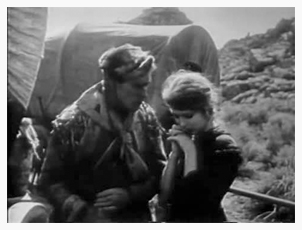

An Artcraft Picture
Released: July 29, 1919
Produced by Thomas H. Ince
Directed by Lambert Hillyer
Cast: William S. Hart ("Buckskin" Hamilton), Jane Novak
(Jane Washburn), Robert McKim (David Washburn), Lloyd Bacon (Guy
Merton), Leo Pierson (Billy Hamilton), Charles Arling (The Captain)
Olive Films' Blu-Ray release of William S. Hart's 1919 melodrama "Wagon Tracks" is beautifully done with a gorgeous tinted print from the Library of Congress and an enjoyable piano score by Andrew Earle Simpson.
Although there are several of Hart's westerns that have been available on home video for quite a few years, not enough of them have shown up on quality DVD releases. A good presentation of "Hell's Hinges" (1916) can be found on the out-of-print "Treasures from American Film Archives: 50 Preserved Films." Image Entertainment has released two Hart features: "Tumbleweeds" (1925) was released in 2002, and "The Toll Gate" was released in 1999. But with approximately 20 of his features known to have shown up in varying quality on either VHS or DVD over the years, it's a shame we can count only four of them being given the quality treatment we see in the aforementioned films and Olive Films' new release of "Wagon Tracks."
It is unknown why Olive Films chose "Wagon Tracks."
It's a good Hart entry - but then again, pretty much all of them
are good. The stories aren't repetitive, but you can always count
 on a Hart film being heavy drama,
a solid story, and the hero as a no nonsense tough guy, but exhibiting
an underlying compassionate nature. The "good-bad man"
persona that was the hallmark of his early films is essentially
that. He may have been a crook, but there was a line he wouldn't
cross. One of those was somewhat of a "reverence" regarding
women.
on a Hart film being heavy drama,
a solid story, and the hero as a no nonsense tough guy, but exhibiting
an underlying compassionate nature. The "good-bad man"
persona that was the hallmark of his early films is essentially
that. He may have been a crook, but there was a line he wouldn't
cross. One of those was somewhat of a "reverence" regarding
women.
"Wagon Tracks" is a supreme example of this. During a scuffle on a riverboat over cheating at cards, Buckskin's (Hart) brother, Billy, is shot and killed. The two other gamblers were Jane's brother, David, and her fiancé, Merton. Jane tried to intervene and is convinced she caused the gun the men were struggling over to fire and blames herself for Billy's death. What she doesn't realize is that her brother, David, actually reached in during the struggle and pulled the trigger. The men convince Jane to say Billy was intoxicated and making unwanted advances toward her to safeguard her from a murder charge. When Buckskin arrives and learns what happened, he said he believes the part that Jane didn't do this intentionally, but he has suspicions about the rest of the story - the intoxication and unwanted advances toward Jane.
As the story moves on, all of our characters are embarking on a wagon train west with Buckskin as their leader. There is a very good psychological element to the story wherein Jane struggles with the lie she has told, and Buckskin struggles with the suspicious circumstances surrounding his brother's death - a death he very much would like to avenge.
We know Jane is the key to resolving this story, but how this will happen is what keeps us intrigued. During the journey when half their water is lost, Jane is touched by Buckskin's kindness as she observes him giving up his daily ration of water for some of the animals or when he tends to a baby for its mother. As she learns of the goodness of this man, she can stand it no longer and tells him the truth - his brother's death came during a struggle over cheating at cards. Although she still thinks she is responsible for the gun going off, Buckskin thinks differently.
Convinced one of the two men killed his brother, he takes both of them, tied at the end of a rope, into the desert and tells them they will walk without water until someone confesses to the killing. It takes more than a day - and the scenes of the three men in the desert and their struggle is intense and enthralling. However, the captives, crazed by the heat and thirst, fight with one another as Buckskin watches with delight. Of course, the truth comes out.
When they are back at the wagon train, a new problem has arisen. On a peaceful visit by the Indians, one of the men overreacted and shot an Indian. The Indians are now demanding a life for a life or they'll attack. Buckskin gives David the choice - he can either shoot himself or go to the Indians. The dilemma is intensified when Jane comes to Buckskin begging for mercy for her brother.
 Hart prided himself on the realism
in his pictures, and the scenes filmed in the desert locations
outside Los Angeles carry a starkness that accentuates the drama
and adds to the believability of the men's harrowing ordeal.
The trek of the wagon train could be taken from a Frederic Remington
painting, and Hart used real Indians in this film to effect the
period look and feel. Night scenes filmed next to a campfire
are especially well done. And the viewer can appreciate this
all the more with Olive Films' superb Blu-Ray presentation.
Hart prided himself on the realism
in his pictures, and the scenes filmed in the desert locations
outside Los Angeles carry a starkness that accentuates the drama
and adds to the believability of the men's harrowing ordeal.
The trek of the wagon train could be taken from a Frederic Remington
painting, and Hart used real Indians in this film to effect the
period look and feel. Night scenes filmed next to a campfire
are especially well done. And the viewer can appreciate this
all the more with Olive Films' superb Blu-Ray presentation.
Hart was certainly a fine actor, and we get ample close-ups of his weathered face as he kneels, teary-eyed, beside his brother's deathbed or agonizes over his desire to send Jane's brother to the Indians or give in to her pleas for mercy. One can't imagine anyone else doing the stories Hart did with as much passion and effectiveness.
He was also, wisely, supported by fine actors. Jane Novak was certainly one of the great beauties of the silent screen and provides a fine performance in this film - drawing out sympathy and approval with her charm. Unfortunately, although she appeared in many films throughout the silent era, Novak was never a star of the first magnitude. She co-starred with Hart in five of his films and was engaged to him at one point - but a marriage never took placed. She made only two films in the thirties, but came back for seven in the forties and three in 1950 before retiring from films.
Everybody's favorite bad guy, Robert McKim, portrays David in "Wagon Tracks," and does his usual superb job. He was one of Hart's favorites appearing in at least seven of the star's films; however, silent film fans most likely remember him best as Captain Juan Ramon in Douglas Fairbanks' "The Mark of Zorro" (1920). McKim unfortunately died at the age of 40 in 1927.
Photoplay magazine said, "William S. Hart deserves unstinted praise for the admirable artistry which characterizes this production throughout," and adds, "The narrative itself is of no great consequence, but the period of the forty-niners is reproduced magnificently, from the great caravans which formed at the headwaters of the Missouri to the far trails in the dust of the desert at the foot of the Rockies." (1)
On the opposite side was Variety who strongly criticized
the author of the story, C. Gardner Sullivan. " . . . what
excuse has he for such a patchwork offering that nowhere coheres
into drama? . . . The real trouble with this picture is that it
is negative. It slides downhill toward revenge. It never climbs
toward the winning of the girl, and that, popularly speaking,
is a  great mistake." The reviewer
does acknowledge, though, "The settings . . . are excellent,
the lighting effects beautiful and the photography for the most
part, up to the mark." (2)
great mistake." The reviewer
does acknowledge, though, "The settings . . . are excellent,
the lighting effects beautiful and the photography for the most
part, up to the mark." (2)
Harrison's Reports found fault in the overall mood of the story. "Everything is good in this picture, that is, construction of story, acting, directing, atmosphere, etc., except the most important thing - mood of story; it is so unsympathetic, that it kills it as an entertainment." The reviewer goes further by noting, "The sight of the corpse at about the beginning of the picture is too repelling for a large number of picture goers. The cruelty the hero shows to the two men whom he drags in the desert, making them suffer thirst so as to compel a confession, is another unsympathetic feature. But the worst one of all is the act of bringing sister against brother. To hide the murderer is bad, but to give away her brother is worse." (3)
As noted earlier, Hart wanted realism, and today's viewers are very unlikely to see "Wagon Tracks" as the harsh story portrayed by two of the reviewers. As a matter of fact, although we like to see the hero and heroine walk off into the sunset as the closing credits come into view, the fact that the two do not unite at the end of this film does not make the story less satisfactory. The relationship wasn't developed to that degree during the course of the narrative, so it's perfectly acceptable. At any rate, when Jane asks if she will see him again, he answers, "Mebbe," so we must assume their paths could cross again. All this being said, there may some minor criticisms, but, overall, it's a good, solid - and typical - Hart western that is well-deserving of a special release.
Olive Films' Blu-Ray release of "Wagon Tracks" was mastered for home video from an original 35mm nitrate print, which was preserved by the Library of Congress - 69 minutes, B&W/color tinted.
References
1. "Wagon Tracks" review. Photoplay Magazine.
December, 1919.
2. "Wagon Tracks" review. Variety. August 15,
1919.
3. "Wagon Tracks" review. Harrison's Reports.
August 16, 1919.
Copyright 2017 by Tim Lussier. All rights reserved.